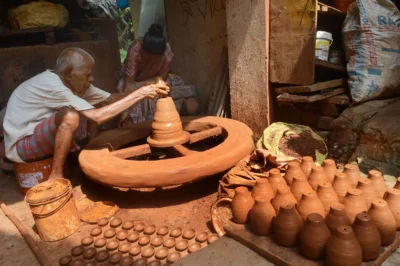In Visakhapatnam’s Kummari Veedhi, 93-year-old Srikakulam Pardes is a living testament to India’s rich pottery heritage. As the last traditional potter in his community, he preserves a craft that dates back generations, using a simple potter’s wheel to create beautiful clay items. Each year, ahead of Deepavali, Pardes handcrafts deepams (oil lamps) and flower pots, supplying local communities with traditional pieces that add authenticity to celebrations.
A Tradition at Risk
In a world rapidly modernizing, the art of pottery in Kummari Veedhi, like many other traditional crafts, is disappearing. Once a bustling neighborhood of artisans, it now houses only Pardes, who has seen his fellow potters transition to other livelihoods as demand dwindled. Despite these challenges, he has chosen to keep the tradition alive, dedicating his time and skill to an art form that is both labor-intensive and deeply spiritual.
The role of potters like Pardes in Indian culture extends beyond mere utility. Clay lamps and pots are integral to traditional celebrations and daily rituals. Each item he crafts tells a story of craftsmanship honed over decades, blending artistry and function in a way few other items do.
Deepavali Preparations: The Demand for Clay Lamps
For Pardes, Deepavali is the busiest time of year. Families across India seek traditional clay lamps to adorn their homes and temples, lighting them as part of the festival’s rituals. Using simple, hand-turned tools, he crafts hundreds of these lamps, creating pieces that add a cultural richness to the holiday. Each lamp, carefully shaped and smoothed, embodies the essence of Deepavali, symbolizing light, purity, and hope.
The Challenges of Keeping a Craft Alive
One of Pardes’ greatest challenges is the waning interest in traditional pottery, as cheaper, machine-made options flood the market. Many artisans have given up, unable to sustain themselves financially. Yet, Pardes continues, driven by a love for his craft and a sense of duty to preserve his heritage. The physical demands of pottery—kneading, shaping, and firing clay—are daunting, especially for someone of his age, yet he persists, proving that passion can indeed overcome adversity.
The rise of environmentally friendly practices, however, offers a glimmer of hope. As people seek alternatives to plastic, eco-conscious consumers are turning back to clay products, boosting demand for traditional pottery. This shift could revive interest in handmade clay items, possibly attracting younger artisans to learn the craft Pardes holds so dear.
Passing the Torch
Pardes’ journey is a reminder of the importance of preserving cultural heritage, particularly in a world that often prioritizes speed and efficiency over tradition. His work raises a poignant question: who will carry on this legacy when he can no longer do so? Efforts to document his craft and involve younger community members in learning pottery techniques are small but hopeful steps toward ensuring that this art form doesn’t disappear altogether.
Conclusion: A Legacy Worth Preserving
Srikakulam Pardes’ story is one of resilience and dedication. In Kummari Veedhi, he stands as a symbol of India’s artistic and cultural richness, proving that tradition and craftsmanship remain relevant and essential. As festivals like Deepavali continue to celebrate light and heritage, Pardes’ work reminds us of the artisans behind these celebrations and the importance of preserving their crafts for future generations.








Leave a Reply